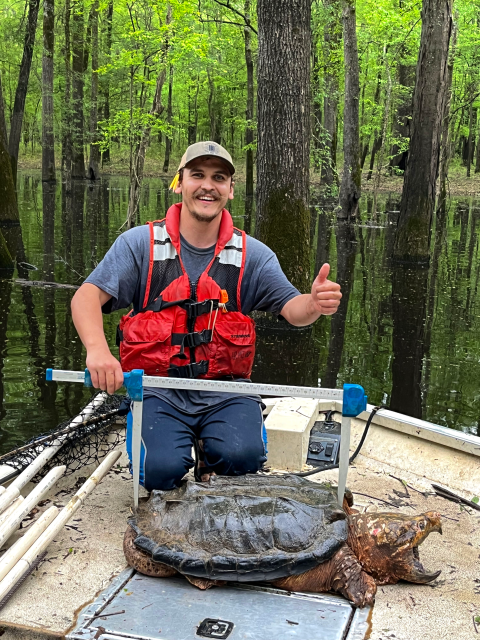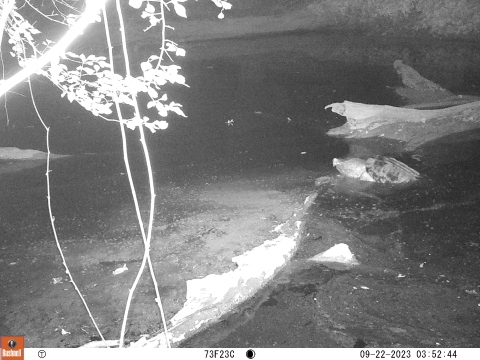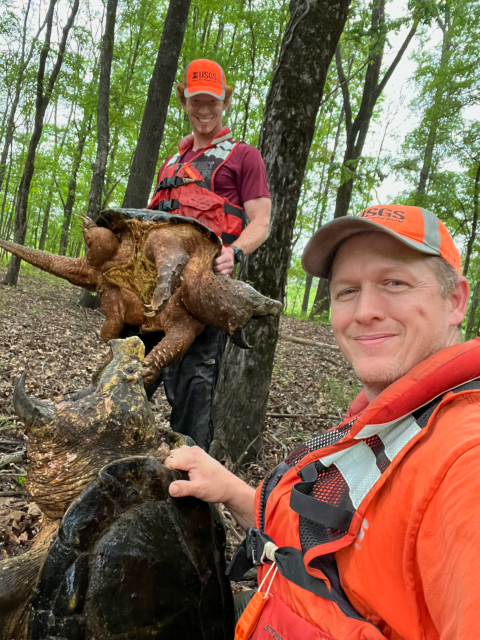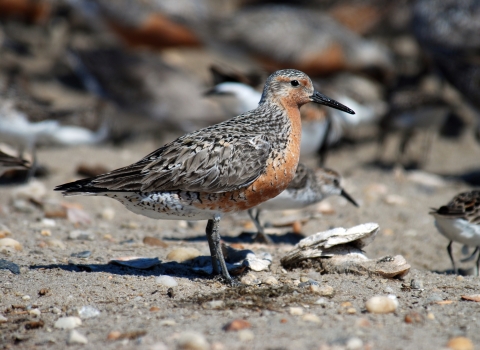Deep in the soggiest, undisclosed corners of the American wilderness, a Mississippi biologist and other researchers trapped and released hundreds of hulking dino-like alligator snapping turtles in the spring and summer of 2024.
Fish and Wildlife Biologist Luke Pearson, the turtle expert studying this species, works at the Mississippi Ecological Services Field Office in Jackson, Mississippi. Pearson’s inspiration to become a champion for turtles came from above.
“I actually had a hawk drop a box turtle into our backyard when I was little,” said Pearson. “We were all outside when it happened, and we literally watched it fall into the backyard, and we were like, what just happened?”
“That kind of stuck with me,” said Pearson.
The surveys in 2024 were part of an ongoing effort to understand more about its population size and health. When the U.S. Fish and Wildlife Service first proposed to list the species as threatened in 2021, the agency relied on expert opinion to form its models. At the time, it was the best science available.
Since then, the agency has intensified research.
“That is kind of the point of the surveys here in Mississippi and elsewhere,” said Pearson. “After going through the species status assessment, after going through the expert elicitation, these are the things we know near nothing about. So how can we fill that in?”
In 2017, Pearson started studying alligator snapping turtle populations as a part of his Ph.D. in Mississippi, before he came to work for the U.S. Fish and Wildlife Service. Having identified several populations of these turtles in the state, the agency hired him to continue his work.
Under his charge, he and grad students from the University of Southern Mississippi have been going to these populations in Mississippi to do “mark and recapture” studies. During these studies, scientists capture turtles, mark them and release them. They continue surveys in these areas comparing the marked ones to the unmarked ones so they can estimate the population’s size.
The other agencies involved in this program are the United States Geological Survey and the Mississippi Department of Wildlife, Fisheries and Parks.
This is challenging work because the species spends most of its time under water, making it difficult to find, and they can weigh hundreds of pounds.
Pearson said he has been the lead on this program but plans on handing over more responsibility to the incoming grad students.
One grad student, Patrick Delisle, stood out with some innovative ideas to help study the creature. One idea that earned him a runner-up award at the Turtle Survival Alliance International Conference involved using game cameras to study populations.
At a site, they pointed the game cameras at the water and set it to take pictures every 60 seconds for around five days. By counting how many times an alligator snapping turtle came up for air, they were able to use that data to create a model to estimate the population size.
The result was a near match to the mark and recapture estimates.
This kind of innovation drives scientists closer to answering the questions the conservation community has about the species. One question is the impact of fishing hooks on the species.
This year, scientists brought some special equipment with them: metal detectors and a portable X-ray machine. It worked.
“We were getting hits for hooks in throats,” said Pearson.
This information is important because the primary threat to the species comes from bycatch on fishing equipment. Pearson said people know that these turtles drown on trot and limb lines, but less is known about what happens with hook swallowing.
“Some people get to their lines before the turtle drowns, but it's an alligator snapping turtle,” said Pearson. “You're not reaching your hand into its mouth to get a hook out, so they're going to cut the line.”
Looking inside the alligator snapping turtle will tell scientists more about the fishing hook threat. They will learn how many turtles are being affected, and what types of hooks they are swallowing the most.
“Maybe the hooks that we are seeing inside the turtles are all J hooks and not circle hooks,” said Pearson. “Maybe they are all circle hooks and not J hooks.”
This data will help state and federal agencies and potentially even fishing gear manufacturers develop regulations to help the species.
The alligator snapping turtle suffered from overharvesting in the 1960s and 1970s throughout a turtle soup fad. Pearson said this species is misunderstood – a noble reason for all this hard work and innovation.
“A lot of people think that these turtles aren’t good for anything, really,” said Pearson. “They think that they eat all their game fish, you know, eat all the catfish and bass, and they're big and mean and want to bite everybody. And they're really not.”
Pearson said they are more evolved than their cousins, the eastern snapping turtle, and they are the largest freshwater turtle in the United States. They are the only species that use their tongue as a lure to catch prey.
“They’re really cool,” said Pearson.
Author’s note: This story omits specific locations to safeguard vulnerable alligator snapping turtle populations from poaching.








